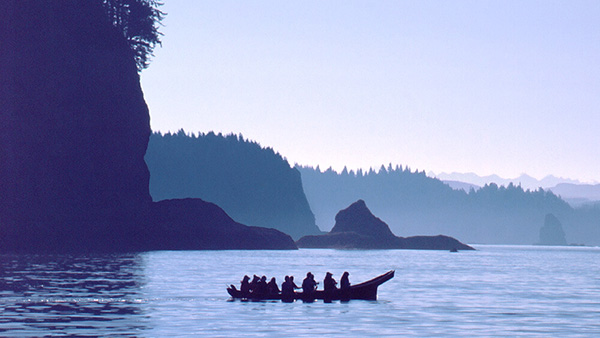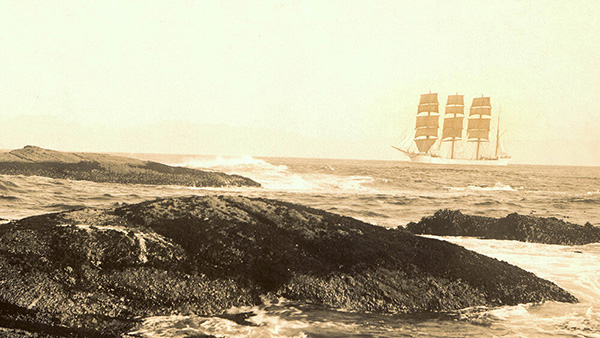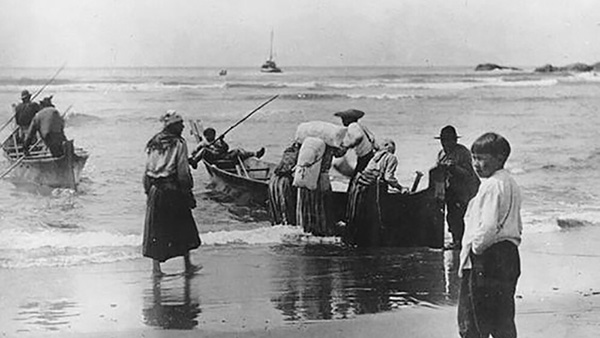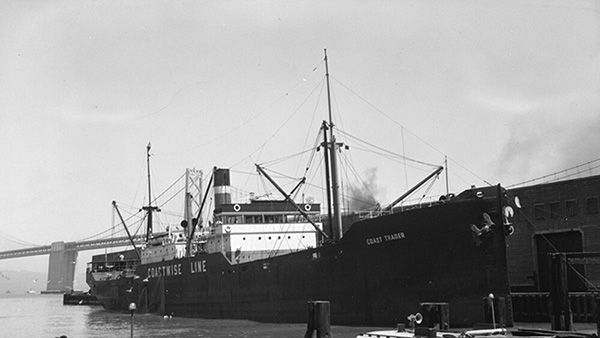American Period
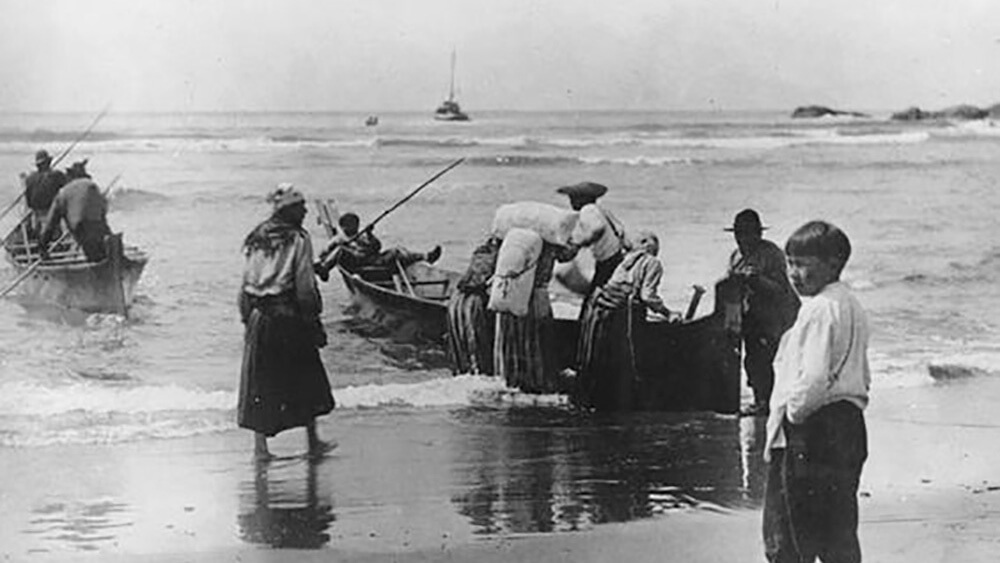
The United States and Britain continued to quibble over the Northwest Oregon Territory through much of the early 19th century. Finally, the land that would become Oregon and Washington states became U.S. territory in 1846 with the 49th Parallel Compromise. The “Great Migration” along the Oregon Trail funneled many settlers to the Northwest. Settlements grew around Puget Sound as lumber became a moneymaking industry. The California Gold Rush of 1849 attracted thousands of miners to California and sparked demand for Puget Sound timber. After Washington became a state in 1853, the pressure from American settlers moving into the area led to the placement of the tribes onto reservations. As commerce intensified in and out of the Puget Sound, the government erected lighthouses at critical nearshore shoals to improve navigation. The lighthouse at Cape Flattery’s Tatoosh Island was built in 1855 on Makah lands and was supplied from the Makah village at nearby Neah Bay.
Treaty of Neah Bay and Treaty of Olympia
The encroachment of settlers had a profound impact on the native tribes’ traditional way of life. The United States pressured the tribes to move to reservations in order to make way for American settlement. In 1855, the Treaty of Neah Bay set aside land at Cape Flattery as a reservation for the Makah Tribe. Tatoosh Island was appropriated for the lighthouse and was not returned to the tribe until 1984. In 1855-1856, the ancestors of the Hoh Tribe, Quileute Tribe, and the Quinault Indian Nation signed the Treaty of Olympia with the U.S. government. The Hoh and Quileute reservations were subsequently established by Executive Order.
Through treaties with the United States, the Hoh Tribe, Makah Tribe, Quileute Tribe, and Quinault Indian Nation reserved hunting, fishing, and gathering rights to access and utilize the plants, mammals, fish, and other resources of the Olympic Peninsula and its adjacent waters in their respective treaty areas, in perpetuity. The marine ecosystem and its associated natural resources form an essential foundation for the economies and cultures of the Coastal Treaty Tribes, and the Coastal Treaty Tribes view the continued ability to harvest and utilize water, plants, mammals, fish, and other resources of this region as being critical to the protection of their treaty rights and the continuity of their distinct societies.
The treaties of the Coastal Treaty Tribes are part of the “Stevens treaties.” These treaties were negotiated in the mid-1850s throughout the lands that are now western Washington with governor of the Washington territory, Isaac Stevens. The 1855 Treaty of Neah Bay with the Makah Indian Tribe and the 1855 Treaty of Olympia with the Hoh Indian Tribe, Quileute Indian Tribe, and the Quinault Indian Nation govern the relationships between the federal government and the Coastal Treaty Tribes.
Developing Economy
It is important to keep in mind that prior to contact with European explorers, there was a well-developed economy in the Pacific Northwest with trade occurring between various tribes. Much of the early contact between the European and Indigenous cultures was associated with the early maritime fur trade. Over time, the focus on trade shifted to settlement with increasing vessels plying the outer coast and the inland waters of the Washington Territory.
In addition to the Territorial Governor securing land for settlers through negotiation with tribal governments, the young United States also worked to map the territory and develop maritime safety infrastructure. The early mapping efforts of Captain George Vancouver and Lieutenant Charles Wilkes were greatly improved by the methodical work of the U.S. Coast Survey from 1851-1853, a predecessor to NOAA. In addition to developing detailed nautical charts, locations for lighthouses were identified. Work continued with the construction of the Cape Flattery and Destruction Island Lighthouses in 1857 and 1892. These aids to navigation were later supported by lightships on Umatilla Reef and Swiftsure Bank in 1898 and 1909.
Despite these efforts to improve maritime safety in the developing Washington Territory, during the last half of the 19th century, increased shipping to and from Puget Sound resulted in increased incidents of shipwrecks along the Olympic Coast. The area is notorious for fog and rain, and winter storms are savage in their intensity. Ships having the misfortune to be caught near the shore risked destruction on the many uncharted submerged pinnacles. Many of the ships that wrecked along the Olympic Peninsula coast at this time were wooden sailing vessels. Ship-rigged “down-easter” barks and multi-masted schooners entering and leaving the straits were frequently wrecked near the coast.
As the regional economy expanded at the turn of the century and communities evolved, other types of vessels appeared in the coastal waters. Steam powered ships brought trade from around the Pacific Rim countries. Iron-hulled ships were slow to enter use in this region due to the paucity of iron manufacturing on the Pacific coast. Timber was so plentiful and cheap that iron shipbuilding could not compete. Puget Sound shipyards, such as the Hall Brothers, built ships of local timber to carry the lumber trade to the rest of the Pacific Rim.
Smaller craft such as California coastal steamers and sail traders, as well as wooden fishing boats, plied the Northwest Coast waters. Many of these smaller craft based themselves at regional ports like those at Neah Bay and La Push, and were sometimes owned by Native Americans. These small wooden steamers soon became a standard in other regions as well, many serving the plantations in the Hawaiian Islands.
In 1888, three Gloucester schooners from Massachusetts were brought in to fish for halibut at the mouth of the Strait of Juan de Fuca, influencing local fishing boat designs. The introduction of gas engines gave rise to Northwest Coast purse seiners. Regional fishers, whalers, and sealers also made use of locally produced boats, seeking popular game fish like salmon and steelhead trout.
By the early 20th century, Norwegian immigrants and their fleets of wooden, diesel-powered purse seiners based in the Puget Sound dominated salmon and halibut fisheries. Sport fishing also became more prominent when private citizens from the cities were able to afford their own powered boats. Salmon and steelhead trout were popular game fish.


